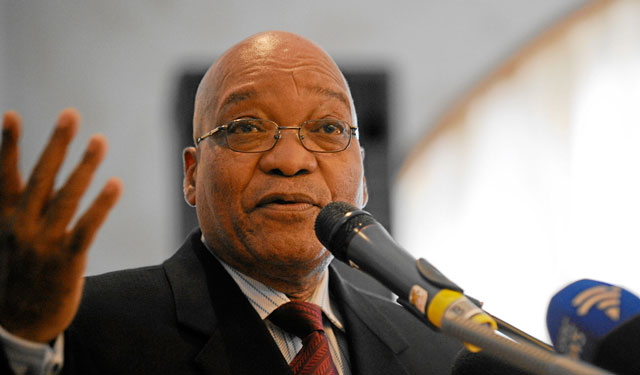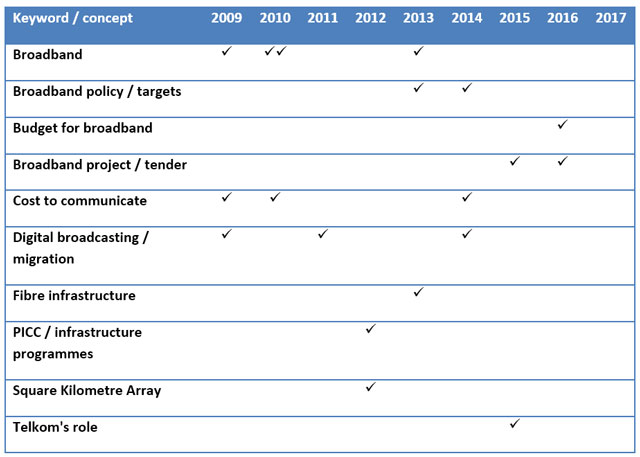
The 2017 state-of-the-nation address (Sona) takes place today, 9 February. In the weeks that follow, the nine premiers will deliver their state-of-the-province addresses. The purpose of these addresses is to outline government policy and direction for the year and also identify specific goals and targets.
What can the ICT industry look forward to in the 2017 Sona? Before we get there, let’s take the time to reflect on the relevant comments in Sonas in the last few years.
Sona 2009
This year marked the first Sona presented by President Jacob Zuma. The comments related to ICT were as follows:
Another development which should boost the World Cup is the roll-out of the digital broadcasting infrastructure and signal distribution transmitters.
Overall, we will ensure that the cost of telecommunications is reduced through the projects under way to expand broadband capacity.
Take note that this was the first time that the terms “digital broadcasting infrastructure”, “broadband” and “cost to communicate” were used in a Sona. The relevance will become important later.
Sona 2010
A year later, and the speech built on that of the previous year:
As part of our efforts to encourage greater economic growth, we are working to reduce the cost to communicate.
The South African public can look forward to an even further reduction of broadband, cellphone, landline and public phone rates.
We will work to increase broadband speed and ensure a high standard of Internet service, in line with international norms.
Yes, we did host the soccer World Cup that year, and by all accounts the communications were world standard.
Communications regulator Icasa also launched its “Cost to Communicate” study, but only in 2013. Once concluded, the study found that “South Africa was ranked 30th out of 46 African countries” and that “despite the decreases in prices over the year, the cost to communicate remained extremely high”. Yes, as consumers, we have seen some progress in voice and data costs, and perhaps we can map the origins of this back to 2010.
Sona 2011
In 2011, there was the briefest of mentions of a commitment to digital migration. It sounded so progressive and like it would be trivial, right?
In communications, we have committed to convert our television and radio signals from the analogue platform to the more advanced digital signal which will enable quality pictures and sound.
Sona 2012
This speech contained scant reference to ICT. There was the bid to host the Square Kilometre Array radio telescope in partnership with eight other African countries – yes, it was good to win that one – and headline details of the Presidential Infrastructure Coordination Commission were introduced. However, no mention was made of the Sip 15 Expanding Access to Communication Technology which outlines a broadband strategy.
Other than that, there was little mentioned that was directly relevant to the ICT sector.
Sona 2013
This speech included a worthwhile objective and some positive feedback:
To prepare for the advanced economy we need to develop, we will expand the broadband network.
Last year, the private and public sector laid about 7 000km of new fibre optic cables. The plan is to achieve 100% broadband internet penetration by 2020.
By this stage, Broadband Infraco was operational and transmission prices were falling like a stone. Telkom Mobile and Cell C were really challenging the status quo for voice and data. The fibre industry was abuzz with the N3 and N1 co-build routes, plus Dark Fibre Africa, FibreCo, Liquid Telecom and others were cutting trenches for new routes criss-crossing our metros and provinces.
Sona 2014
In 2014 we were on a roll with a minister of communications that we believed in, a new policy and new energy. Digital migration here we come!
We will expand, modernise and increase the affordability of information and communications infrastructure and electronic communication services, including broadband and digital broadcasting.
Cabinet adopted “South Africa Connect”, our broadband policy and strategy, in December last year to take this mission forward.
Sona 2015
At last, some decent traction with the outlining of plans to advance broadband:
The year 2015 will mark the beginning of the first phase of broadband roll-out. Government will connect offices in eight district municipalities.
These are Dr Kenneth Kaunda in North West, Gert Sibande in Mpumalanga, OR Tambo in the Eastern Cape, Pixley ka Seme in the Northern Cape, Thabo Mofutsanyane in the Free State, Umgungundlovu and Umzinyathi in KwaZulu-Natal, and Vhembe in Limpopo.
Government has also decided to designate Telkom as the lead agency to assist with broadband roll-out.
You may recall the hasty restatements and clarifications from the ministry that followed over Telkom’s role as “lead agency”.
Listed here are the district municipalities targeted for the NHI pilot programme and for broadband – more on them later.
This was also the year of the cellphone jammer in parliament — #BringBackTheSignal.
Sona 2016
If you listened carefully (!), broadband received a mention under point 9d of the Nine-Point Plan:
During the state-of-the-nation address in February 2015, I announced the Nine-Point Plan to respond to sluggish growth.
The Nine-Point Plan consists of…
…i iv. Broadband roll-out
We have made significant progress in the implementation of the plan.
Government will fast-track the implementation of the first phase of broadband roll-out to connect more than 5 000 government facilities in eight district municipalities over a three-year period.
Funding to the tune of R740m over a three-year period has been allocated in this regard.
This was the first hint of the State IT Agency’s June 2016 broadband tender and real statement of funding (note that the 2016 department of telecoms & postal services budget, delivered a month later, allocated R1,6bn to phase 1 of broadband roll-out to the eight designated municipalities). But, what and where was this “significant progress”? Telkom apparently declined to bid for the tender, which was subsequently cancelled. However, at least the tender details gave the ICT industry some insight into government’s “plan” for broadband roll-out.
Summary and Sona 2017
The table below summarises the key themes and their re-occurrence in the last eight Sonas:

Given that the ICT industry accounts for around 6% of GDP, and that the telecoms sector alone has invested over R175bn in infrastructure since 2009, one would expect that the sector should attract some decent airtime during the Sona. I’m not sure what the president is going to report on with the stalled processes for digital migration — perhaps the reissue of the broadband tender?
Anyway, bring out the popcorn and let’s keep our eyes peeled for that briefest of mentions of the sector we hold so dear and know has the capability to propel our country firmly into the 21st century.
- Tim Parle is director at BMI-TechKnowledge




